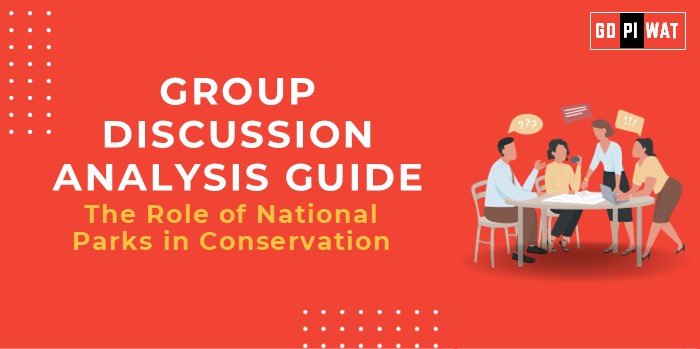📋 Group Discussion Analysis Guide: The Role of National Parks in Conservation
🌐 Introduction to the Topic
- 📜 Opening Context: National parks play a crucial role in preserving biodiversity, serving as protected habitats for countless species. With increasing threats like deforestation, climate change, and human encroachment, their significance has never been more critical.
- 🌍 Topic Background: The concept of national parks originated in the U.S. with the establishment of Yellowstone National Park in 1872. In India, Jim Corbett National Park, established in 1936, laid the foundation for wildlife conservation efforts. Recent policies like Project Tiger and Project Elephant emphasize the continued importance of these protected areas.
📊 Quick Facts and Key Statistics
- 🌏 Global Protected Areas: Over 15% of Earth’s land area is under protection (UNEP, 2023).
- 🌳 India’s Protected Areas: 106 national parks covering 1.33% of the total land area.
- 🐅 Key Species Conservation: 70% of the world’s tigers are in Indian national parks.
- 🦚 Biodiversity Impact: Protected areas shelter 30% of terrestrial and marine biodiversity globally.
🤝 Stakeholders and Their Roles
- 🏛️ Governments: Designate and manage protected areas, implement wildlife protection laws.
- 🌱 NGOs: Conduct conservation programs, research, and awareness campaigns.
- 👥 Local Communities: Act as custodians and beneficiaries of conservation efforts.
- 🌐 Global Organizations: Provide funding and technical expertise (e.g., IUCN, WWF).
🏆 Achievements and Challenges
✨ Achievements:
- 🐅 Successful Tiger Population Recovery: Through initiatives like Project Tiger.
- 🌟 Improved Ecotourism: Generating $77 billion globally annually (WTTC, 2023).
- 🌿 Ecosystem Restoration: Revitalization of Sariska and Ranthambore ecosystems.
⚠️ Challenges:
- 🏗️ Encroachment: Habitat fragmentation due to developmental projects.
- ⚔️ Human-Wildlife Conflicts: Rising near protected areas.
- 💸 Underfunding: Inadequate resources for park management and conservation.
🌍 Global Comparisons:
- ✅ Success: Kenya’s Maasai Mara serves as a model of community-integrated conservation.
- ❌ Challenges: Brazil’s Amazon parks face deforestation despite protection.
📌 Case Study: The reintroduction of cheetahs in Kuno National Park highlights India’s commitment to biodiversity restoration but underscores logistical challenges like ensuring prey availability.
💡 Structured Arguments for Discussion
- ✅ Supporting Stance: “National parks are indispensable for species conservation as they provide safe habitats and promote biodiversity.”
- ❌ Opposing Stance: “Merely declaring protected areas without addressing core issues like poaching and human encroachment limits their effectiveness.”
- ⚖️ Balanced Perspective: “National parks are vital but need integration with broader community participation and sustainable practices.”
📝 Effective Discussion Approaches
🚀 Opening Approaches:
- 📊 Begin with a compelling statistic about endangered species.
- 📖 Share a case study like the role of Kaziranga in rhino conservation.
🔄 Counter-Argument Handling:
- ⚡ “While national parks are effective, integrating buffer zones can enhance success.”
- 🌎 Use global examples to showcase varied outcomes.
🔍 Strategic Analysis of Strengths and Weaknesses
- 💪 Strengths: Biodiversity preservation, ecotourism potential.
- 🔻 Weaknesses: Underfunding, inadequate staffing.
- 🌟 Opportunities: Use of technology like drones for monitoring.
- ⚠️ Threats: Climate change and illegal wildlife trade.
🎓 Connecting with B-School Applications
- 🏢 Real-World Applications: Topics for projects could include sustainable tourism models or biodiversity policy frameworks.
- 📝 Sample Interview Questions:
- “How can national parks balance conservation and tourism?”
- “Evaluate the role of community-based conservation.”
- 💡 Insights for B-School Students:
- Focus on stakeholder collaboration in projects.
- Develop financial models for sustainable park management.


